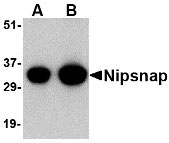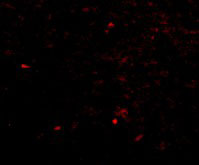NIPSNAP Antibody
- 产品详情
- 实验流程
- 背景知识
Application
| WB, IF, E, IHC-P |
|---|---|
| Primary Accession | Q9BPW8 |
| Other Accession | NP_003625, 193211616 |
| Reactivity | Human, Mouse, Rat |
| Host | Rabbit |
| Clonality | Polyclonal |
| Isotype | IgG |
| Calculated MW | 33310 Da |
| Concentration (mg/ml) | 1 mg/mL |
| Conjugate | Unconjugated |
| Application Notes | NIPSNAP antibody can be used for the detection of NIPSNAP by Western blot at 0.5 - 1 µg/mL. Antibody can also be used for immunohistochemistry starting at 2.5 µg/mL. For immunofluorescence start at 20 µg/mL. |
| Gene ID | 8508 |
|---|---|
| Other Names | Protein NipSnap homolog 1, NipSnap1, NIPSNAP1 |
| Target/Specificity | NIPSNAP1; |
| Reconstitution & Storage | NIPSNAP antibody can be stored at 4℃ for three months and -20℃, stable for up to one year. As with all antibodies care should be taken to avoid repeated freeze thaw cycles. Antibodies should not be exposed to prolonged high temperatures. |
| Precautions | NIPSNAP Antibody is for research use only and not for use in diagnostic or therapeutic procedures. |
| Name | NIPSNAP1 {ECO:0000303|PubMed:30982665, ECO:0000312|HGNC:HGNC:7827} |
|---|---|
| Function | Protein involved in mitophagy by facilitating recruitment of the autophagy machinery required for clearance of damaged mitochondria (PubMed:30982665). Accumulates on the mitochondria surface in response to mitochondrial depolarization and acts as a 'eat me' signal by recruiting proteins involved in selective autophagy, such as autophagy receptors (CALCOCO2/NDP52, NBR1, SQSTM1/p62, TAX1BP1 and WDFY3/ALFY) and ATG8 family proteins (MAP1LC3A, MAP1LC3B, MAP1LC3C, GABARAP, GABARAPL1 and GABARAPL2) (PubMed:30982665). |
| Cellular Location | Mitochondrion matrix |
| Tissue Location | Ubiquitous (PubMed:9661659). Highest expression in liver (PubMed:9661659). |
For Research Use Only. Not For Use In Diagnostic Procedures.
Provided below are standard protocols that you may find useful for product applications.
BACKGROUND
NIPSNAP Antibody: NIPSNAP is a member of an evolutionarily well conserved gene family and has a strong sequence similarity to the central portion of a protein encoded by C. elegans chromosome III between a 4-nitrophenylphosphatase (NIP) domain and non-neuronal SNAP25-like protein. Recent studies have indicated that NIPSNAP is involved in the regulation of the Ca2+-selective transient receptor potential vanilloid channel 6 (TRPV6). NIPSNAP1 associates with TRPV6 at the plasma membrane and inhibits TRPV6 currents. Other studies show that NIPSNAP's expression is reduced in the phenylketonuria (PKU) mouse brain, suggesting that NIPSNAP may play a role in memory.
REFERENCES
Seroussi E, Pan H-Q, Kedra D, et al. Characterization of the human NIPSNAP1 gene from 22q12: a member of a novel gene family. Gene1998; 212:13-20.
Schoeber JP, Topala CN, Lee KP, et al. Identification of Nipsnap1 as a novel auxiliary protein inhibiting TRPV6 activity. Pflugers Arch.2008; epub.
Surendran S, Tyring SK and Matalon R. Expression of calpastatin, minopontin, NIPSNAP1, rabaptin-5 and neuronatin in the phenylketonuria (PKU) mouse brain: possible role on cognitive defect seen in PKU. Neurochem. Int.2005; 46:595-9.
终于等到您。ABCEPTA(百远生物)抗体产品。
点击下方“我要评价 ”按钮提交您的反馈信息,您的反馈和评价是我们最宝贵的财富之一,
我们将在1-3个工作日内处理您的反馈信息。
如有疑问,联系:0512-88856768 tech-china@abcepta.com.























 癌症的基本特征包括细胞增殖、血管生成、迁移、凋亡逃避机制和细胞永生等。找到癌症发生过程中这些通路的关键标记物和对应的抗体用于检测至关重要。
癌症的基本特征包括细胞增殖、血管生成、迁移、凋亡逃避机制和细胞永生等。找到癌症发生过程中这些通路的关键标记物和对应的抗体用于检测至关重要。 为您推荐一个泛素化位点预测神器——泛素化分析工具,可以为您的蛋白的泛素化位点作出预测和评分。
为您推荐一个泛素化位点预测神器——泛素化分析工具,可以为您的蛋白的泛素化位点作出预测和评分。 细胞自噬受体图形绘图工具为你的蛋白的细胞受体结合位点作出预测和评分,识别结合到自噬通路中的蛋白是非常重要的,便于让我们理解自噬在正常生理、病理过程中的作用,如发育、细胞分化、神经退化性疾病、压力条件下、感染和癌症。
细胞自噬受体图形绘图工具为你的蛋白的细胞受体结合位点作出预测和评分,识别结合到自噬通路中的蛋白是非常重要的,便于让我们理解自噬在正常生理、病理过程中的作用,如发育、细胞分化、神经退化性疾病、压力条件下、感染和癌症。








